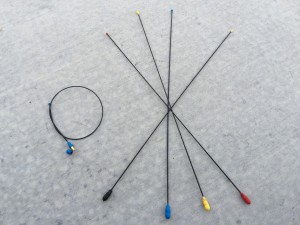Many recently have asked for reviews of the SuperElastic Signal Stick antenna. I can’t provide an unbiased review, since I’m the one who keeps the project going and organizes build-it nights to keep them stocked, but I thought I’d share with you some of the details of the construction.
If anyone wants to post a youtube review please let me know and I’ll link to it from this page. If you have trouble with yours, please contact me before doing the review and give me a chance to correct it — not because I want to hide any actual flaws, but because we do have a lifetime warranty and I want to make sure you’re reviewing the working product. I’ve had much fewer than 1% of the antennas sold ever returned for any reason (defect or breakage, both of which are covered), but accidents do happen when building this by hand.
The origin of the Super-Elastic Signal Stick
SWR readings
One important difference between most handheld antennas and base station antennas is that handheld antennas are far less stable (from an SWR perspective) than a base station antenna. Do not expect to connect this to an SWR meter or antenna analyzer and get a 1:1 reading; you actually might get that reading, but it will depend on where you are standing, how close to the radio you are standing, how far from your body it is, what is nearby, what other RF fields there are, ….
The reason for this is that you are using half of a dipole; that’s really what a 1/4 wave antenna (and the vast majority of handheld antennas) is. The other half of the dipole is…. your arm, the radio, etc. This means that the actual SWR is going to tend to be all over the place, and that ends up being just fine. The nice thing about a 1/4 wave antenna is that unlike a “rubber duck” or other compromise antenna they have a relatively wide frequency coverage, and so they actually work very well despite all of this variance.
The exceptions to this rule are antennas which use a matching section to put both halves of a dipole into the antenna, which is something we don’t have the manufacturing capability to do. In addition, Super-Elastic Signal Sticks are designed to be a simple, durable, all-purpose go-to antenna which can be easily coiled up for storage. Making them more high-tech and complicated would probably do more damage in making them more breakable than it would help.
If you have any questions, please feel free to ask them in the comments and I’ll answer as best I can.

